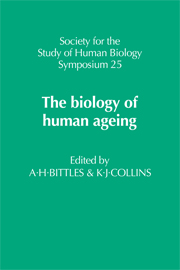Book contents
- Frontmatter
- Contents
- Preface
- Ageing as a consequence of natural selection
- Genetic information in ageing cells
- Insects as models for testing theories of ageing
- Human cell culture systems in the study of ageing
- Estimation of biological maturity in the older child
- Biological age assessment in adulthood
- Skeletal age and palaeodemography
- Cell death and the loss of structural units of organs
- The prospects for mortality decline and consequent changes in age structure of the population
- Where do old people come from? An evaluation of American population projections
- Age structure of Soviet population in the Caucasus: facts and myths
- The health of an ageing population
- Can we tell our age from our biochemistry?
- Dietary manipulation of ageing: an animal model
- Customary physical activity in the elderly
- Effects of ageing on human homeostasis
- Index
Customary physical activity in the elderly
Published online by Cambridge University Press: 06 August 2010
- Frontmatter
- Contents
- Preface
- Ageing as a consequence of natural selection
- Genetic information in ageing cells
- Insects as models for testing theories of ageing
- Human cell culture systems in the study of ageing
- Estimation of biological maturity in the older child
- Biological age assessment in adulthood
- Skeletal age and palaeodemography
- Cell death and the loss of structural units of organs
- The prospects for mortality decline and consequent changes in age structure of the population
- Where do old people come from? An evaluation of American population projections
- Age structure of Soviet population in the Caucasus: facts and myths
- The health of an ageing population
- Can we tell our age from our biochemistry?
- Dietary manipulation of ageing: an animal model
- Customary physical activity in the elderly
- Effects of ageing on human homeostasis
- Index
Summary
INTRODUCTION
The companion papers presented in this volume give full accounts of the sheer size of the elderly population in various societies, the state of the physical and mental health of elderly people, and their social and nutritional requirements. Concern has been expressed about both the quality of life and the length of life, and those fundamentally different ideas are also reflected within the field of activity measurement by a parallel interest in both the intensity and the duration of physical work. In younger subjects we are usually interested in measuring customary physical activity (or inactivity) because of its supposed relation with risk of cardiovascular disease, with energy balance and obesity, and with physiological capacities (particularly capabilities for sport and work). In older people, our attention focusses very sharply on the potentially vicious spiral of inactivity leading to physical deconditioning and thence, via loss of physiological capacity, to a further decline in activity (Bassey, 1978; Bassey et al, 1983; Evans, this volume). Ultimately the penalty is dependence and institutionalization; and the relevant criterion for physiologists, medical practitioners, epidemiologists and health care planners alike is not simply life expectancy but “active life expectancy” (Katz et al, 1983) with its connotations of independence and well-being. These are exemplified by the reputed lifestyles of the centenarians of the Caucasus (Medvedev, this volume).
We rather expect elderly people who have lived and worked in an industrial society to become less active in retirement, irrespective of their actual capacities and capabilities. The phrases “put your feet up” and “now you can take it easy” come freely when we talk to people of our parents’ generation.
- Type
- Chapter
- Information
- The Biology of Human Ageing , pp. 243 - 260Publisher: Cambridge University PressPrint publication year: 1986
- 1
- Cited by

